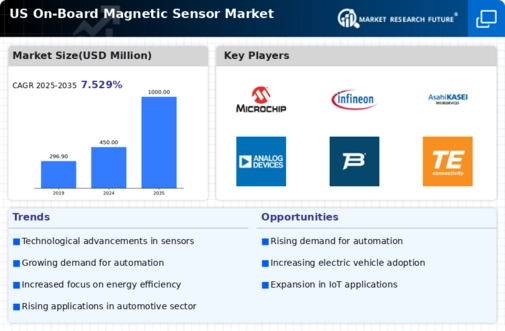Expansion of Consumer Electronics
The proliferation of consumer electronics in the US is significantly impacting the on board-magnetic-sensor market. With the rise of smart devices, including smartphones, tablets, and wearables, the demand for compact and efficient sensors is on the rise. The on board-magnetic-sensor market is projected to grow as manufacturers seek to incorporate advanced sensing technologies into their products. For instance, the market for wearables is expected to reach $60 billion by 2025, creating a substantial opportunity for magnetic sensors. These sensors are essential for applications such as navigation, motion detection, and orientation sensing, which are increasingly integrated into consumer electronics. As technology continues to evolve, the on board-magnetic-sensor market is likely to see a surge in demand driven by the need for enhanced functionality and user experience.
Rising Adoption of Electric Vehicles
The increasing adoption of electric vehicles (EVs) in the US is driving the on board-magnetic-sensor market. As manufacturers strive to enhance vehicle performance and efficiency, the integration of advanced sensors becomes crucial. The on board-magnetic-sensor market is expected to benefit from the projected growth of the EV sector, which is anticipated to reach a market size of $800 billion by 2027. This shift towards electrification necessitates precise monitoring of various vehicle parameters, where magnetic sensors play a pivotal role. Furthermore, the demand for improved safety features in EVs is likely to propel the need for reliable sensor technologies, thereby expanding the on board-magnetic-sensor market. As automakers increasingly focus on innovation, the integration of these sensors is expected to become a standard practice in the automotive industry.
Growing Demand for Smart Home Technologies
The rising demand for smart home technologies in the US is contributing to the growth of the on board-magnetic-sensor market. As consumers increasingly seek convenience and energy efficiency, the integration of advanced sensors in home automation systems becomes vital. The on board-magnetic-sensor market is poised to benefit from the projected growth of the smart home market, which is expected to reach $174 billion by 2025. Magnetic sensors are essential for applications such as security systems, smart locks, and environmental monitoring. This trend towards smart living solutions is likely to drive the adoption of on board-magnetic sensors, as manufacturers aim to enhance the functionality and reliability of their products. The convergence of technology and consumer preferences is expected to create new opportunities within the on board-magnetic-sensor market.
Increased Focus on Automation and Robotics
The growing emphasis on automation and robotics across various industries in the US is influencing the on board-magnetic-sensor market. As businesses seek to improve operational efficiency and reduce costs, the integration of advanced sensors in automated systems becomes essential. The on board-magnetic-sensor market is expected to expand as industries such as manufacturing, logistics, and healthcare increasingly adopt robotic solutions. The market for industrial automation is projected to reach $300 billion by 2026, indicating a robust demand for reliable sensing technologies. Magnetic sensors are critical for applications such as position sensing and feedback control in robotic systems. This trend towards automation is likely to drive innovation and investment in the on board-magnetic-sensor market, as companies strive to enhance their competitive edge.
Advancements in Aerospace and Defense Applications
The advancements in aerospace and defense applications in the US are significantly impacting the on board-magnetic-sensor market. As the demand for precision and reliability in these sectors increases, the need for advanced sensing technologies becomes paramount. The on board-magnetic-sensor market is expected to grow as aerospace manufacturers and defense contractors seek to enhance their systems with cutting-edge sensors. The aerospace sector alone is projected to reach $1 trillion by 2030, indicating a substantial opportunity for magnetic sensors. These sensors are critical for applications such as navigation, attitude control, and system monitoring in aircraft and defense systems. The ongoing investments in research and development within these industries are likely to drive innovation and expansion in the on board-magnetic-sensor market.






















Leave a Comment